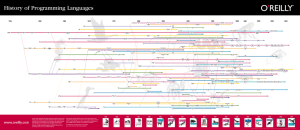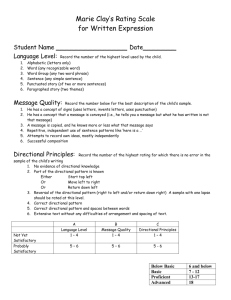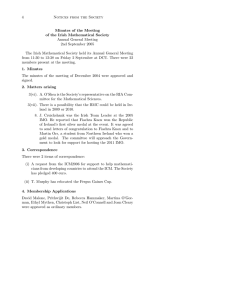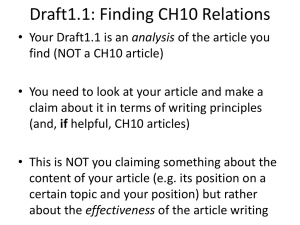Traffic analysis - site traffic distribution
advertisement
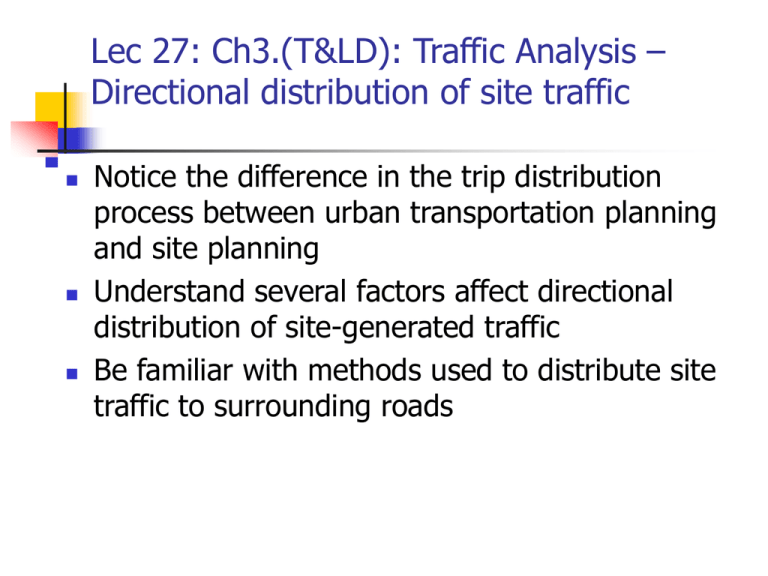
Lec 27: Ch3.(T&LD): Traffic Analysis – Directional distribution of site traffic Notice the difference in the trip distribution process between urban transportation planning and site planning Understand several factors affect directional distribution of site-generated traffic Be familiar with methods used to distribute site traffic to surrounding roads Directional distribution of site traffic The assumptions and method used in estimating the direction in which traffic will approach and depart the site will vary with several location-specific conditions, such as; Size of the proposed development Type of development (e.g. industrial, commercial, residential, etc.) Prevailing conditions on the existing street systems Available data base Avoid evaluating TIA based on “mechanical method” A very good warning from the authors. Choose a method appropriate for the situation rather than using a canned procedure. (P.49) Primary market Analogy OD (easy said, hard done) Gravity method (we did this already.) Primary market The primary market (area-of-influence) method utilizes a unique trade area or area of influence. It is the geographical area from which a high percentage (80%) of the sitegenerated traffic will be “drawn” to the site. The boundary of the trade area might be identified by one of the following techniques: Method 1: Delineate the trade area as a regular geometric shape (a circle or square with the site at the center) with a radius of travel appropriate for the type of development Method 2: Delineate the trade area by establishing the most distant points that can be reached within some selected travel time over the specific street system Method 3: Use Reilly’s Law of Retail Gravitation to establish the boundary between competing centers Maximum travel times (how far people travel?) Travel time (not distance) and trip purposes are the determinants of trip length. Community shopping center: 15-20 min Neighborhood shopping: 10 min Industrial park: 30 min Residential: peak-hour = 30 min; Other = 20 min Method 1: Defining the study area Step 1: Select the appropriate max trip length for the study site Step 2: Draw the selected geometric shape (a circle or a rectangle) with the center located over the site (Steps 2 & 3) Method 1: Defining the study area (cont) Step 3: Divide the trade area into sections (zones) and determine the amount of activity in each. Step 4: Calculate the proportion of each section (zone) as a percentage of the total primary market area (Step 4) Method 1: Defining the study area (cont) Step 5: Identify the most logical route from the centroid of each section (zone) to the site. Step 6: Calculate the directional distribution by assigning the percentage from step 4 to the minimum paths identified in step 5. 34%, not 14% (Step 5) Method 2 This method uses the travel distance calculated along each route using the appropriate maximum travel time and the travel speed(s) on each street. Results in an irregular geometric shape. Steps 1 and 2. Travel time = say 10 min. Speeds on routes are different resulting in different distances. Steps 3 through 6 are the same as Steps 3 through 6 of Method 1. (Hah!? No shape shown!) Method 3: Reilly’s Law of Retail Gravitation (used when competing markets exist) Reilly’s law: PA A d AB dA PB 1 PA Pi: size of center I, commonly measured in 1000 sq. ft. of gross leasable area PB dA dAB A’s market boundary B Method 3: Reilly’s method (used when competing markets exist) (cont) Once the boundary is defined, the rest is like step 3 though 6 of Method 1. 14 min 11 min 15 min (See page 53 for an example) Analogy (p.54) Identify existing situations which have the “same” characteristics as expected of the subject. A traffic survey of a similar development in close proximity to the subject site follows this methodology. In many cases, a manual count of turn movements is sufficient to obtain the necessary data for analysis of the direction of approach. With a large development where there are several approach streets, a license-plate survey might be used (find out how customers drive through the network to get to the site). Similar site Subject site (See p.54 for possible applications) Analogy (p.54) (cont): Example in p.54 (Turn movements used to determine traffic distribution) (Assumed site-traffic distribution) Find out % distribution: from north or from south Note that these two sites face the same Main St.
